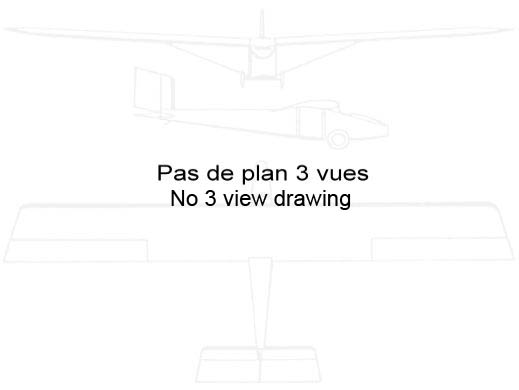
Rostock M-II Mecklenburg
| DONNÉES GÉNÉRALES |
| Année du premier vol (ou de design, si seul projet) |
1929 |
| Pays | Allemagne |
| Designer(s) | KREKEL, P. |
| Premier constructeur | Mecklenburgischer Aero-Klub, Rostock (DE) |
| Type d'appareil | Planeur |
| Fonction | Entraînement |
| SPÉCIFICATIONS TECHNIQUES |
| Envergure | 12.1 m |
| Longueur | -- |
| Hauteur | -- |
| Allongement | 6.1 |
| Surface alaire | -- |
| Profil aile | -- |
| Masse à vide | 121.5 kg |
| Masse maxi | 261.5 kg |
| Charge alaire | -- |
| Vitesse mini | -- |
| Vitesse maxi | -- |
| Finesse maxi | |
| Taux de chute mini | 0.87 m/s |
| Nb sièges | 2 |
| Structure | Tubes d'acier soudés et toile |
AUTRES INFORMATIONS
| Constructeur(s) |
| ||||||
| Infos techniques | -- | ||||||
| Histoire résumée | The Rostock Aero Club of Mecklenburg devoted themselves to the further development of the light school two-seater. Under the direction of Dipl.-Engineer Krekel the "Baumeister M I," known from its appearance at the 1928 glider meeting, was improved and entered in the 1929 meeting as type M II. The wing, with its aspect-ratio improved in comparison with the previous year, is in two sections it has two spars, with wire bracing in the inner panels and rigid diagonals in the outer wing portions. The individual details, such as attachments, rib details, etc., were even more carefully carried out and as far as possible standardised. All the other parts of the aircraft, such as the body and the empennage, were carried out in hollow steel construction. The body, a roomy enclosure as in the previous year, is longer and higher than the nacelle of M I. Dual control is provided, with detachable control levers. Doped fabric serves as a covering for the nacelle. The cabane is arranged to be detachable, and is built up of streamlined steel tubing. The junction of the four opposing cables is so arranged that the cables can be tightened or relaxed by means of one turn-breckle, which naturally simplifies the rigging and dismantling and makes it possible during school practice to connect up the cables without much expenditure of labour. The fuselage is carried out in the usual way as a plain framework, likewise of steel tubing, and is braced to the wing. Elevator and rudder control mechanism composed of fixed and movable surfaces are likewise of steel tube construction. The horizontal stabilising fin can be set for trimming purposes. Both rudder and elevator are elliptical in outline. This school aircraft was, as regards its specific weight, the lightest at the meeting, the structural weight of the whole machine being 5 kg. per sq. metre. | ||||||
| Liens personnalités | KREKEL, P. (Allemagne) |
SOURCES DOCUMENTAIRES
| Liens WEB | Pas de site référencé. |
| Livres | Forschen-Bauen-Fliegen par LEMKE, Frank-Dieter & JACOB, Rolf (2010) [p. 36. Note]. |
| Autres sources | Technical report of the Rhön glider meeting 1929, par A. Lippisch, Wasserkuppe, Rhön, The British Gliding Association Journal vol. 1 n° 3, janvier 1931 p 66-82. Publié in "Zeitschrift fiir Flugtechnik und Motorluftschriffahrt," volume 21, No. 4, p. 92 ; editeur R. Oldenbourg, Munich. Texte + specs. |

Team J2mcL © 2003 -
- Pages optimisées pour Mozilla Firefox

